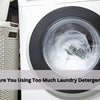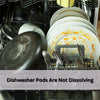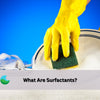Top 10 Toilet Cleaning Myths Busted
- by Brodie Cook

You might have heard a lot of tips and tricks about hygiene and cleaning your toilet. Maybe you’ve even wondered if some of them are true. From leaving the cleaner in overnight to thinking vinegar is enough, toilet cleaning myths pop up all the time.
It’s easy to get mixed messages, but not all of them are right. Let’s clear them up so you can keep your toilet in pristine condition.
Myth: Toilet Cleaners Without Harsh Chemicals Don’t Work as Well
You might have heard that if a toilet cleaner doesn’t have strong chemicals, it’s not going to work. Some people think you need bleach or harsh cleaners to tackle tough stains and odours.
The truth is, a lot of those strong chemical smells and foams are just for show. What really matters is how well the cleaner breaks down grime and bacteria. Our toilet cleaning sheets use safe, plant-based ingredients that get the job done. They lift stains, cut through grime and help reduce bacteria without using harsh chemicals that can harm pipes or the planet.
These cleaners are tough on dirt but gentle on your home. So you get a fresh, clean toilet and you don’t have to worry about what’s going down the drain.
Myth: Leaving Toilet Cleaner in Overnight Cleans Better
You might have heard that leaving a toilet cleaner in overnight will give you a better clean. It sounds like it should work, but it’s not really true.
Toilet cleaners only need a few minutes to do their job. Leaving them in too long can damage your toilet. It can weaken the seals inside the bowl and wear down the finish. This can lead to leaks or stains that are hard to fix.
It can also affect the air in your bathroom. Many cleaners release VOCs (volatile organic compounds). These can build up in the air if the cleaner sits for hours, making your bathroom less pleasant to breathe in.
For a good clean without damage or bad air, stick to the product’s instructions. A few minutes is all it takes.
Myth: You Should Leave the Lid Open to Let It Dry
You might have heard that leaving the lid open after cleaning helps it dry out faster. Some think it helps stop odours and keeps the toilet looking fresh.
But leaving the lid open when you flush can actually spread water droplets around the room. This is called toilet plume, and it can land on surfaces like counters and toothbrushes. Closing the lid stops that spray and keeps your bathroom cleaner.
If you’re worried about moisture or smells, there’s a better way. Let the cleaner do its job, then close the lid and flush. After that, open the bathroom door or run a fan for fresh air. This way, your bathroom stays dry and you avoid unwanted messes.
Myth: Vinegar Cleans Just as Well as Commercial Toilet Cleaners
Some people believe vinegar can clean everything in the bathroom, even the toilet. It’s true that vinegar can break down some hard water stains and limescale. It’s great for light cleaning on smooth surfaces.
But vinegar falls short when it comes to cleaning a toilet bowl properly. It doesn’t remove tough deposits like uric acid build-up or hard water rings that sit under the water line. It also doesn’t help with the biofilm that can form in hidden spots in the bowl.
These deposits need a cleaner that’s made to tackle them. Vinegar alone just can’t cut it for these tougher jobs.
Myth: Mixing Bleach with Other Cleaners Boosts Cleaning Power
You might have heard that if one cleaner works well, two together must work even better. But mixing bleach with other cleaners doesn’t make them stronger. It makes them dangerous.
When bleach is mixed with acidic or ammonia-based cleaners, it can create toxic gases. These fumes can irritate your eyes, skin, and lungs. They can also linger in the bathroom and make it hard to breathe.
Always read the labels. Never mix different cleaners. Use one product at a time and rinse well before switching. That’s how you keep your bathroom clean and your home safe.
Besides that, bleach is such a harsh chemical, and there are better alternatives to that! (our cleaning sheets)
Myth: Blue Toilet Tablets Keep Your Toilet Clean for Months
Blue toilet tablets might look like they’re keeping things clean because the water turns blue. But that colour doesn’t mean your toilet is really clean.
These tablets don’t reach hidden spots like under the rim or deep in the trap. They can also leave behind residues in your tank that build up over time. This can block flush valves, slow down the flush, and lead to expensive repairs.
Blue tablets can even release chemicals that stay in the air, especially in small bathrooms. That’s not something you want to breathe in every day.
To see how blue toilet bowl tablets can damage your toilet tank and plumbing, check out this detailed guide on blue toilet tablet damage and maintenance tips
Myth: Toilet Cleaners Are All the Same
It’s easy to think all toilet cleaners work the same way. Some people grab the cheapest option on the shelf or stick with what they’ve always used.
But not all toilet cleaners are made the same. Some use harsh chemicals that can damage the bowl’s surface or your pipes if overused. Others use gentle, plant-based ingredients that clean just as well but are kinder on your bathroom and the planet.
Some cleaners work fast and need a quick scrub, while others are meant to sit for a bit to break down stains. The right choice depends on what your toilet needs and what you’re comfortable using in your home.
Myth: Using More Cleaner is Better
Some people think that using a lot of cleaner will make the toilet sparkle faster. But more doesn’t always mean better.
Using too much cleaner can leave behind a sticky residue in the bowl. This can actually attract more dirt and make it harder to flush clean. It can also wear down the parts inside the toilet over time.
The best way to clean is to use the right amount of product. Follow the directions on the label and give the cleaner a chance to work. This keeps your toilet fresh and avoids build-up.
Myth: Hot Water Cleans the Toilet Better
It’s often thought that hot water cleans the toilet better. People think the heat helps remove marks and stains more quickly.
But toilets are made of ceramic or porcelain, and hot water can damage these surfaces over time. It can also weaken seals and cause leaks if you’re not careful.
Cold or lukewarm water with a toilet cleaner is all you need to get the job done safely.
Myth: Dish Soap Works Fine for Toilet Cleaning
It’s often thought that dish soap can handle any cleaning job, even in the toilet. After all, it cuts through grease in the kitchen, so why not here?
The truth is, dish soap isn’t made for the mineral deposits or residue found in toilets. It can help remove some surface dirt, but it won’t tackle the buildup that forms around the rim and in the trap. It can also create a lot of foam that’s hard to rinse away and may mess with the flush.
If you want to see what dish soap is really designed for, check out these gentle and effective dishwashing detergent sheets. They’re perfect for the kitchen, but best to leave dish soap out of the toilet bowl.

 Dishwashing
Dishwashing Laundry
Laundry Bundles
Bundles Surfaces
Surfaces Toilet
Toilet Handsoap
Handsoap Multi-Purpose
Multi-Purpose Floor
Floor



